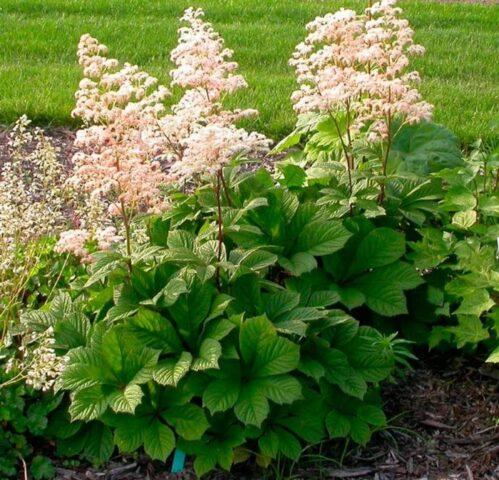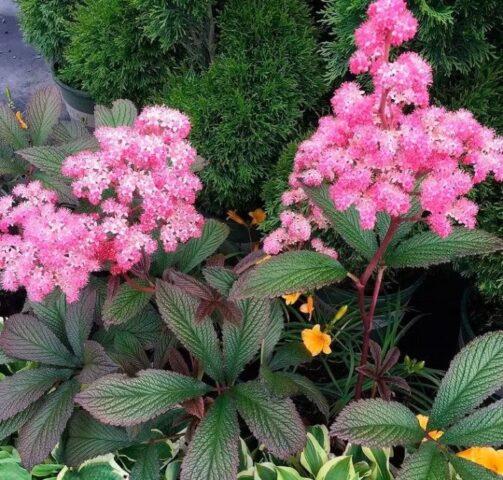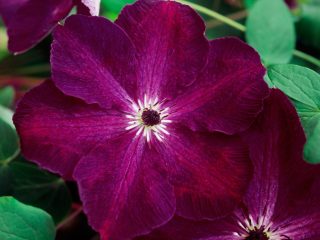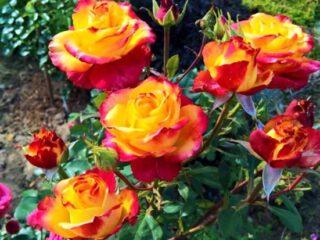Content
Rogersia chestnut leaf is one of the best shade-loving plants. Decorates the garden with attractive foliage of various colors from light green to red-brown, copper and bronze. It blooms mainly in the second half of summer and produces very fragrant flowers collected in large panicles. At the same time, it remains decorative until mid-autumn.
Description of Rogers chestnut leaf
Rogersia chestnut leaf is a low perennial plant. Due to the similarity of the leaf blades with horse chestnut, it is also called horse chestnut leaf.
Rogersia is distinguished by a very strong rod system, which is especially well developed in young representatives. As the stems mature, they produce adventitious roots. Moreover, thick rhizomes then produce layering directly above the soil surface, covering a large space.
The height of Rogers chestnut-leaved plant in favorable conditions reaches 1.5 m (peduncles) and 80-100 cm (the bush itself). At the same time, it is small in width - only 50-60 cm. The plants are compact and look very beautiful. The leaves are palmately divided and form a spectacular clump. Young foliage is red-brown, then turns green. They are very large, up to 50 cm wide.
The plates are well textured. Their colors come in a variety of colors, including shades of copper, bronze or metal. Rogers chestnut leaves are well attached to powerful stems. The shoots are erect, spreading, and bend quite well to the sides. Therefore, they do not break even under strong gusts of wind.
The flowers are quite dense, fragrant, and white. They are also large in size, collected in paniculate inflorescences up to 30 cm high. They appear in the second half of summer, the flowering of Rogers chestnut leaf lasts until the end of August (total period 4-6 weeks). After this, fruits - boxes are formed.
Varieties of Rhodessia chestnut-leaved
In nature, Rogersia grows on the Japanese islands, in Southeast Asia, and on the Korean Peninsula. It is also found in Tibet, Nepal and China. There are only five known species of chestnut-leaved Rogersia. However, breeders managed to develop several dozen varieties. Many of them can be grown in the climatic conditions of Russia (up to the Urals):
- Rogersia centifolia is a beautiful variety with brownish-red leaves. The shrub can reach a height of 1.6 m. It blooms in the second half of June.
- Rogersia elderifolia is a low shrub, reaching only 60 cm.The leaves are large, bright green. It is unpretentious.
- Rogersia pinnate is a beautiful shrub with leaf blades of different shapes. The color is bright green, and by autumn it becomes bronze-red.
- Rogersia Nepalese is distinguished by the shape of its leaves: the petioles are elongated, and notches are noticeable on the edge. The color is quite interesting - from light yellow to greenish-blue shades.
Planting Rogers chestnut leaf
Planting can be planned for both autumn and spring. The first option is more preferable, since after wintering the plant takes root in a new place, and in the spring it begins to grow. The site should be prepared in advance. The soil is dug up and fertilized with compost or humus in an amount of 10 kg per 1 m2. If the soil is too heavy or clayey, it must be enriched with sand or sawdust - up to 5 kg for the same area.
Rogersia chestnut leaf is quite demanding on the soil. She prefers loose and fertile soils; loam with a slightly acidic or neutral reaction (pH in the range of 6-7) is well suited. If in doubt, you can check this indicator using indicator paper or a special device (pH meter).
At the same time, Rogers chestnut leaf is undemanding to the place of cultivation. It can be planted in shade or partial shade. It is not advisable to make a flower bed in the sun, since the plant is accustomed to a lack of sunlight. The soil should be dry, without stagnant water after rain. It is advisable to place the flowerbed near bushes or buildings that protect the flowers from draft winds.
When planting Rogers chestnut leaf, you need to proceed as follows:
- Prepare a planting hole of such depth and width that the roots of the seedling are placed freely (take with a small margin).
- Pour a layer of drainage.
- Place the seedling in the center and straighten the roots.
- Then sprinkle with soil and tamp down a little, deepening the root collar by 5 cm.
- Water with settled water and mulch with bark, sawdust, peat or other material.
Caring for Rogersia chestnut leaf
The plant is quite demanding to care for, although in general the rules are quite simple. Particular attention should be paid to watering and fertilizing. If you do them regularly (and at the same time in moderation), the bushes will produce lush, beautiful flowers and equally attractive leaves.
Watering and fertilizing
Rogers chestnut leaf is watered regularly. This is a moisture-loving plant that requires quite a lot of water. Moreover, it must be warm, so the liquid must first be settled. If it rains, you should rely on the weather forecast and provide moisture as needed. Regular watering and fertilizing will ensure lush flowering.
If there is no precipitation, Rogers chestnut leaf needs to be watered weekly, and during drought - twice a week. The jet is directed to the root zone, covering the entire space, since the roots grow well. It is important to ensure that the soil never remains dry, but at the same time is not waterlogged.
After watering, the soil is loosened. This should be done carefully, at a shallow depth, so as not to damage the roots. Mulch is also placed on the surface. To saturate the soil with oxygen, Rogers chestnut-leaved plants are hilled several times during the planting season.This will allow the soil to maintain moisture and normal density. If necessary, do weeding.
In the first season after planting, it is not necessary to fertilize the plants. But starting from the second year, fertilizing is done regularly. In spring, chestnut-leaved Rogersia especially needs nitrogen. It can be given in the form of ammonium nitrate or urea (15 g per 10 l).
Then, throughout the season, it is necessary to apply complex formulations (at intervals of 3-4 weeks) containing the main components, including phosphorus, potassium, copper, magnesium and zinc. It is advisable to alternate mineral compositions with organic matter, for example, mullein (1:10) or bird droppings (1:20). It is strictly forbidden to use fresh manure, as it burns the root system and can lead to the death of Rogers chestnut-leaved plant.
Transfer
Transplantation of Rogers chestnut leaf is usually planned for the fall. The procedure is normally done every eight years, as the plants age, grow and lose their decorative appearance. But if the flowerbed is located in an open place (bright sun) or in a lowland (stagnant water), the transplant should be carried out in the near future. This is especially important if the plants look unhealthy, the foliage has lost its beautiful color, and the roots have begun to rot.

Only mature, heavily overgrown bushes should be replanted.
Rogersia chestnut leaf should be replanted at the very beginning of October. The sequence of actions is as follows:
- Water the soil thoroughly so that a dense ball of earth forms around the roots.
- The next day, walk around the perimeter with a shovel, then carefully dig and pry up the plant with a rake.
- Divide the bush into several parts so that each rhizome is 8-10 cm long.
- Treat with a growth stimulator and transplant into previously prepared holes.
- On the eve of frost, mulch, trim and, if necessary, cover with agrofibre.
Preparing Rogers chestnut leaf for winter
In the second half of summer and early autumn, it is necessary to begin preparing Rogers chestnut leaf for the winter period. First, cut off all wilted flower stalks (if seeds are not needed) and dying foliage.
At the beginning of September, the bush is hilled up, and in October it is cut almost to the root and carefully mulched with dry leaves, peat, humus or other materials. If the winter in the region is not very snowy, cover the top with non-woven polypropylene fabric with a density of 40-60 g per square meter.
Rogersia chestnut leaf can withstand frosts down to -20 degrees, some varieties up to -25. Therefore, in the south, in the Black Earth Region, and regions of the North Caucasus, it can be grown without shelter. In other areas, mulch must be made and agrofibre laid. Film cannot be used, as it will cause the plant to rot and may even die due to temperature changes.
Diseases of Rogersia chestnut leaf
The Rogersia chestnut leaf plant has fairly good immunity, but due to regular over-watering it can suffer from root rot. Because of this, the foliage darkens and withers, then dies. We have to replant the bush to a new place.
The Rogersia chestnut leaf plant can also suffer from rust fungus. In this case, all diseased leaves and shoots are destroyed, and healthy parts of the bush are treated with fungicides:
- "Bordeaux mixture";
- "HOM";
- "Abiga Peak";
- "Maksim".

Rogersia is quite resistant to diseases
Reproduction
Rogersia chestnut leaf can be propagated in several ways. As a rule, it is propagated by cuttings or dividing the bush, but new seedlings can also be obtained from seeds. The main methods are described below.
Seeds
Seeds are purchased from trusted suppliers and sown in moist, fertile soil mixture as early as March. They are placed in a room with zero temperature for two weeks, then grown in cool conditions (10-15 degrees), watered regularly.
As soon as the seedlings grow to 15 cm, they are planted in separate pots. Then they continue to grow at home. In early autumn they are transferred to the garden, then trimmed and carefully mulched for the winter.
Cuttings
Rogersia chestnut-leaved cuttings are traditionally planned for early summer. To do this, cut off several young shoots 10-15 cm long, shorten the leaves by half, make an oblique lower cut and a straight upper cut. Then they are placed in a solution of a growth stimulator overnight and transferred to moist, fertile soil. They are grown in a nursery until autumn, transplanted to a permanent place, and then mulched for the winter.
Dividing the bush
They begin dividing the Rogersia chestnut-leaved bush in early October. The bush is dug up and the rhizome is cut into several sections with healthy buds. They are treated with a solution of a growth stimulator, then planted 5-7 cm in fertile soil. It needs to be grown in pots in cool conditions (temperature up to 10 degrees). At the end of May, Rogers chestnut leaf sprouts are transplanted into open ground.
Why doesn't Rogersia chestnut leaf bloom?
Sometimes the plant may stop blooming. In most cases, the causes of this phenomenon are associated with improper care:
- Infertile, too dense soil - it is necessary to replant by adding a fertile mixture with humus, peat and sand into the planting hole.
- Too much sunlight - the flowerbed should be in partial shade.
- Through winds.
- Dry air, insufficient watering.
- Also, Rogersia chestnut leaf may stop blooming due to disease.
- Lack or irregular feeding.

If a plant does not bloom, the reason is almost always due to improper care.
Rogersia chestnut-leaved in landscape design
The compact size of chestnut-leaved Rogers allows it to be grown in any area. The shrub is decorative throughout the season. It decorates the garden with beautiful foliage, as well as pleasant, fragrant flowers. Moreover, after they wither, the plant regains its greenery, thanks to which it again looks attractive.
Rogersia chestnut leaf is used in flower beds that are located in partial shade. It can be used for single plantings and various compositions with woody perennials. Used in plantings along the perimeter of paths and flower beds, as a border plant. Excellent for artificial ponds. It harmonizes with low shrubs, dwarf, creeping conifers, for example, thuja and juniper.
Some options for using Rogers chestnut leaf in landscape design are presented below:
- Landing next to the path.
- Single landing.
- Group planting of Rogers.
- Flowerbed decorated with stones.
Conclusion
Rogersia chestnut leaf adorns the garden with large leaves with attractive colors and distinct texture.This is a very interesting plant that is well suited for growing in shady and dry areas. Looks harmonious in a single planting and in different compositions.

















